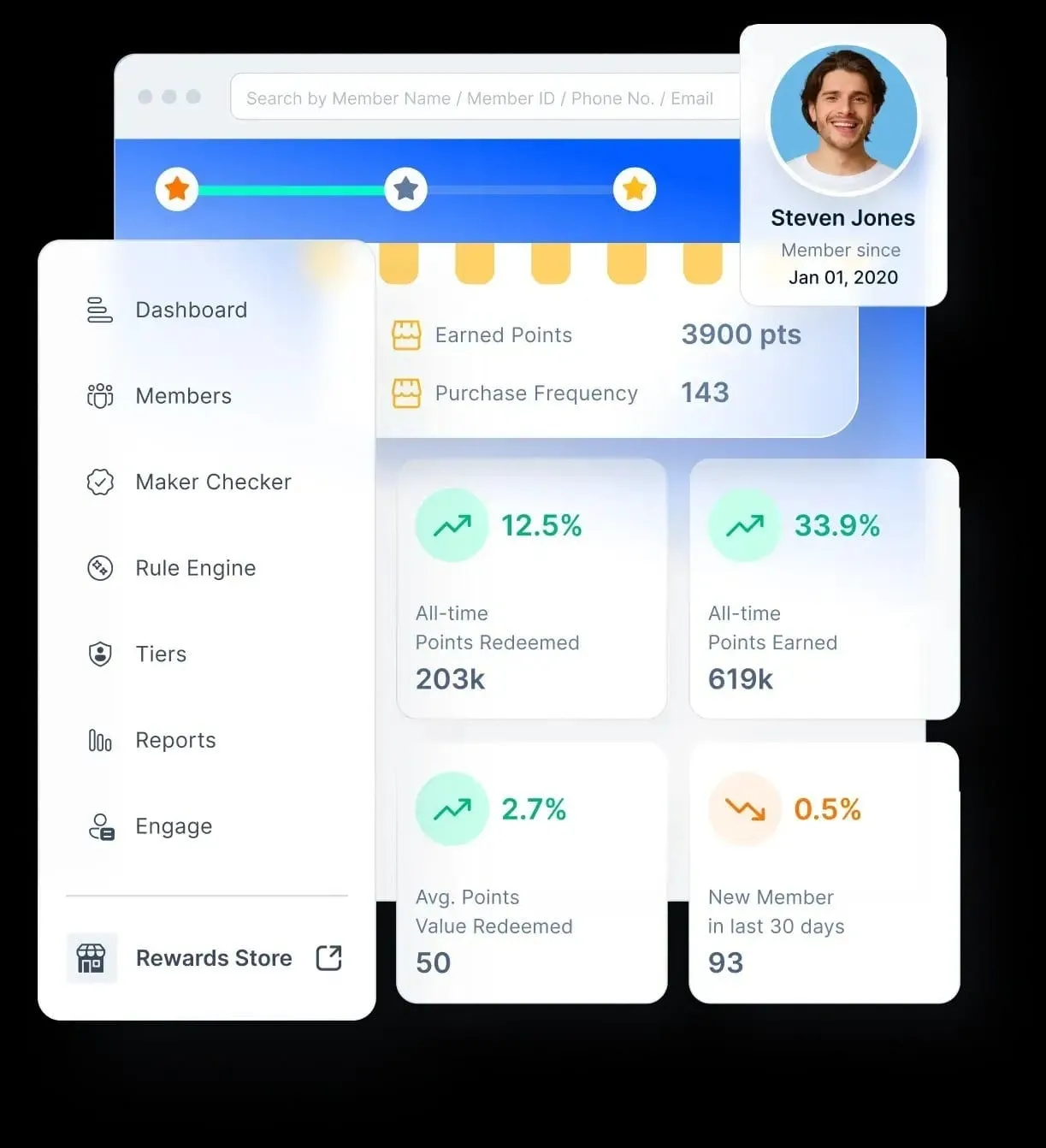How to Run a Successful Customer Retention Program
Retaining customers is more cost-effective than acquiring new ones. A strong customer retention program ensures long-term business growth, increased revenue, and brand loyalty. Learn effective strategies, key metrics, and how to create a program that keeps customers engaged.
On this page
A thriving business isn’t just about attracting new customers, it’s about keeping them. Customer retention programs help businesses build lasting relationships, improve brand loyalty, and increase revenue.
Since repeat customers spend 67% more than new ones, a well-crafted retention strategy is crucial for sustainable growth. In this guide, we’ll explore proven strategies, key metrics, and actionable steps to create a successful customer retention program.
Studies show that increasing customer retention rates by just 5% can boost profits by up to 95%, making retention programs a strategic investment for any business.
What is a customer retention program?
Customer retention refers to the ability to keep customers returning for repeat purchases over time. A loyal customer who makes multiple transactions within a year holds greater long-term value than several one-time buyers.
By prioritizing customer satisfaction and fostering loyalty, businesses can create a dependable revenue stream and strengthen lasting relationships with their existing clientele.
Why does customer retention matter?
Take a look around your space—chances are, you’ll spot a product from a well-established brand, one that has secured its place as an industry leader. Such success doesn’t come from one-time transactions alone. In fact, returning customers tend to spend 67% more overtime than first-time buyers.
High customer retention is a strong indicator that a business is consistently meeting or surpassing expectations. It plays a crucial role in driving long-term revenue, strengthening brand recognition, and establishing industry authority—key factors in building a sustainable, thriving company. Customer retention programs can bring several benefits to your business no matter your industry:
- Lower costs: Retaining existing customers is far more cost-efficient than acquiring new ones. When customers return, their continued spending helps balance out the investment made in acquiring them, reducing overall customer acquisition costs (CAC).
- Increased revenue: Selling to repeat customers—whether through upgrades, add-ons, or complementary products—is a highly effective way to boost revenue. Since they already trust your brand and understand its value, conversions happen more easily than with first-time buyers.
- Enhanced brand loyalty: Satisfied customers are more likely to remain loyal and recommend the brand to others, fostering organic growth through word-of-mouth referrals.
- Improved customer lifetime value (CLV): Retained customers contribute more overtime, increasing their overall value to the business.
- Positive word-of-mouth marketing: Loyal customers often become brand advocates, sharing their positive experiences and attracting new customers.
Keep them coming back: 13 customer retention strategies that work
Boosting customer retention starts with delivering an exceptional experience. By focusing on customer needs and providing consistent, high-quality support, businesses can strengthen relationships and improve long-term loyalty. Here are eight effective strategies to keep your customers engaged and coming back.
1. Provide omnichannel support for seamless communication
Customers expect convenience, and offering omnichannel support ensures they can reach you on their preferred platform. By integrating customer interactions across email, chat, phone, and social media, businesses create a smoother experience and faster resolutions. This approach allows agents to access past conversations, making interactions more personalized and efficient.
2. Respond to customer queries promptly
Fast response times significantly impact customer satisfaction. Even if an issue can’t be resolved immediately, acknowledging the query and providing an estimated resolution time reassures customers that their concerns matter. Setting clear expectations helps reduce frustration and builds trust in your brand’s commitment to customer care.
3. Personalize every customer interaction
No one likes repeating themselves when seeking support. Equip your team with customer service software that provides full customer context, including previous interactions and preferences. This enables agents to offer tailored solutions and build stronger relationships, making customers feel valued and understood.
4. Customer loyalty reward
Show appreciation to loyal customers by offering exclusive perks that incentivize continued engagement. Consider implementing:
- Loyalty programs that reward repeat purchases.
- Discount codes or early access offers for special promotions.
- VIP events to create a sense of exclusivity.
Personalized rewards not only encourage retention but also provide valuable customer insights that can further refine your marketing strategies.
5. Leverage referral programs
Referral programs are a win-win: they boost customer retention while also bringing in new business. Customers are more likely to refer friends when incentivized with:
- Cash rewards
- Free products or merchandise
- Store credits
Since referred customers trust recommendations from people they know, these programs create a powerful and cost-effective customer acquisition channel.
6. Invest in employee happiness
Customer satisfaction starts with engaged employees. A positive work environment fosters motivation and enhances the quality of customer interactions. Businesses that prioritize employee well-being experience lower turnover rates, which means a more knowledgeable support team that can consistently deliver excellent service.
7. Gather and act on customer feedback
Listening to your customers is crucial for retention. Conducting regular surveys—asking about their experiences, challenges, and preferences—provides valuable insights for improvement.
Pair survey feedback with insights from frontline customer support agents to identify patterns and make necessary adjustments to enhance the customer experience.
8. Build a loyalty program
A loyalty program is a great way to incentivize customers to keep coming back. Offer rewards for repeat purchases, referrals, or social media engagement. Make sure the rewards are valuable and relevant to your customers.
9. Spark excitement with thoughtful updates
If customers lose interest in your brand, refreshing your look can reignite engagement. A website revamp, store redesign, or product rebranding can make an old favorite feel new again. However, sudden or drastic changes may alienate loyal buyers—so balance innovation with familiarity.
Coca-Cola’s infamous “New Coke” experiment is a prime example. While the product revamp backfired, the overwhelming public response reinforced consumer loyalty to the original formula.
Similarly, McDonald’s drives excitement by bringing back the McRib for limited runs, leveraging the power of anticipation and exclusivity to keep customers returning.
10. Humanize customer interactions
Consumers crave authentic, human experiences—not robotic responses. AI chatbots, while efficient, often fail to provide the empathy and understanding that human interactions offer.
Direct, meaningful engagement helps businesses build trust and gain valuable insights into customer preferences. Recognizing customers as individuals, rather than just data points, strengthens relationships and encourages repeat business.
11. Align with customer values to build loyalty
People want to support brands that reflect their values. Aligning your business with a meaningful cause—whether donating a portion of profits to environmental conservation or supporting social initiatives—gives customers an emotional incentive to stay loyal. When customers feel good about where they shop, they’re more likely to return and advocate for your brand.
12. Make shopping more accessible with flexible payment plans
The “Buy Now, Pay Later” (BNPL) model is transforming the way consumers shop. With options like Klarna, Afterpay, or Affirm, customers can make purchases without immediate financial strain. Studies show that shoppers are more likely to buy from businesses offering installment payments, making it a powerful tool for customer retention. By providing flexible payment options, you can remove affordability barriers and keep customers coming back.
13. Gamify the shopping experience
Gamification taps into the natural desire for rewards and engagement, turning shopping into an interactive experience. Retailers successfully use loyalty programs that convert spending into redeemable points, incentivizing repeat purchases. By introducing fun challenges, tiered rewards, or exclusive perks, you transform customer interactions into an ongoing journey—one that keeps them invested in your brand over the long term.
Key customer retention metrics to measure
Tracking the right customer retention metrics helps businesses understand how well they are keeping customers engaged and satisfied over time. By analyzing these key indicators, you can identify areas for improvement, strengthen customer relationships, and drive long-term business growth.
Customer retention rate
Perhaps the most obvious way to measure customer retention is with customer retention rate. This metric shows the percentage of customers who remain loyal to your business over a specific period of time.
First, you’ll need to identify the time period you want to measure—whether that be a month, a quarter, or a year. Next, identify the number of customers at the start of the period, the customers who you gained during the period, and the customers at the end of the period. Put it all together, and you get the following formula:
Customer churn rate
A less direct indicator of customer retention is your churn rate—the percentage of customers lost during a period of time. Companies that struggle with customer service retention usually have a high churn rate.
Low retention rates or high churn rates could be bad signs, indicating that something about your customer experience isn’t going well. But don’t panic—there are several changes you can make to turn the churn around.
Customer lifetime value
Customer lifetime value measures the total revenue you can expect from a customer during their lifetime and helps a business discover its most loyal customers. The longer a customer remains loyal to a company, the higher their lifetime value becomes.
For example, a customer who signs up with a 50 percent discount and then closes their account would have a low lifetime value. Businesses will want to find what customer groups have the highest lifetime value to maximize profits and discern mutual opportunities.
Repeat customer rate
The repeat customer rate accounts for all customers who have made two or more purchases. This is a popular customer retention metric among e-commerce businesses that can be applied to other business models.
Purchase frequency rate
Purchase frequency rate shows how much repeat business you get over a given amount of time. The time period can range anywhere from a week to several years. However, it’s generally a best practice to calculate this annually to get a clear view of fluctuations and the role that certain factors—such as seasonality—play in this information.
Run loyalty programs to boost customer retention with Loyalife

Loyalife provides a seamless and adaptable platform designed to drive customer retention and loyalty. Offering businesses the tools to deliver personalized rewards and engagement strategies enables deeper customer relationships, fostering brand loyalty and encouraging repeat purchases.
Why choose Loyalife?
- Loyalty engines: Loyalife empowers businesses to create highly personalized rewards and experiences. From exclusive offers to custom perks, the platform enables companies to cater to each customer’s unique preferences and behavior, enhancing satisfaction and loyalty.
- Omnichannel engagement: Reach and engage customers across a wide array of touchpoints, such as mobile apps, websites, and in-store interactions. This multi-channel approach ensures a consistent and seamless experience, meeting customers wherever they are in their journey.
- Advanced analytics & security: Harness real-time data to make informed decisions and refine loyalty programs. With robust security features, businesses can also mitigate fraud risks, ensuring customer trust and program integrity.
Loyalife is the ultimate solution for businesses aiming to stay ahead in a competitive market by continually adapting to customer needs.
Get started with Loyalife today!
FAQ’s
1. How does customer satisfaction (CSAT) impact retention?
CSAT measures how satisfied customers are with a product, service, or experience. Higher CSAT scores are directly linked to better customer retention, as satisfied customers are more likely to stay loyal and continue doing business.
2.What is the relationship between retention rate and revenue growth?
High retention rates typically lead to higher revenue growth. Retained customers are more likely to make repeat purchases, upgrade services, or refer new clients, all of which contribute to long-term revenue increases.
3. What is the retention cost?
Retention cost refers to the expenses associated with retaining existing customers, such as loyalty programs, customer service, and engagement initiatives. It’s essential to balance retention costs with the value generated from loyal customers.
4. How can referral rates indicate customer retention?
Referral rates measure the likelihood of customers recommending a business to others. Higher referral rates suggest strong customer satisfaction and loyalty, key indicators of successful retention strategies.
5. How does customer engagement relate to retention?
Customer engagement measures how actively customers interact with a business. Higher engagement often leads to higher retention, as engaged customers are more likely to stay loyal, provide feedback, and participate in additional offerings.
6. What is the impact of onboarding on customer retention metrics?
Effective onboarding is crucial for retention. A smooth onboarding process helps customers quickly realize the value of a product or service, leading to higher satisfaction and lower churn rates.
7. How do upsell and cross-sell metrics affect retention?
Upselling and cross-selling opportunities are indicators of a healthy customer relationship. Successfully upselling or cross-selling enhances the customer experience and increases customer lifetime value, both of which contribute to retention.
8. What role does customer service play in retention metrics?
Exceptional customer service directly impacts retention by ensuring customer satisfaction, resolving issues promptly, and strengthening trust. Businesses with strong customer service tend to have lower churn rates and higher retention rates.
9. What is a Net Promoter Score (NPS), and why is it important?
NPS is a metric that measures customer satisfaction and loyalty by asking customers how likely they are to recommend a company’s product or service. A high NPS score correlates with higher customer retention rates.
10. How can businesses improve retention based on these metrics?
To improve retention, businesses should regularly monitor their retention metrics, identify pain points, and implement targeted strategies such as personalized offers, loyalty programs, and improved customer service. Using these insights helps refine retention strategies for better results.









